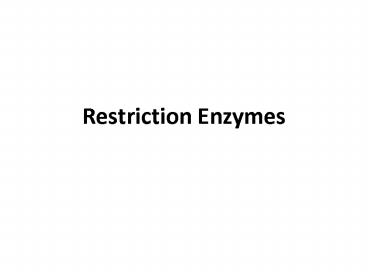Restriction Enzymes PowerPoint PPT Presentation
1 / 15
Title: Restriction Enzymes
1
Restriction Enzymes
2
Molecular Scissors
- Restriction enzymes are molecular scissors
3
- Restriction Enzymes scan the DNA code
- Find a very specific set of nucleotides
- Make a specific cut
4
Picking a palindromeWords that read the same
forwards as backwards
- Hannah
- Level
- Madam
hannaH leveL madaM
5
Palindromes in DNA sequences
- Genetic palindromes are similar to verbal
palindromes. A palindromic sequence in DNA is one
in which the 5 to 3 base pair sequence is
identical on both strands (the 5 and 3 ends
refers to the chemical structure of the DNA).
6
- Each of the double strands of the DNA molecule is
complimentary to the other thus adenine pairs
with thymine, and guanine with cytosine.
7
- Restriction enzymes recognize and make a cut
within specific palindromic sequences, known as
restriction sites, in the genetic code. This is
usually a 4- or 6 base pair sequence.
Example?
8
HaeIII
- HaeIII is a restriction enzyme that searches the
DNA molecule until it finds this sequence of four
nitrogen bases.
5 TGACGGGTTCGAGGCCAG 3 3 ACTGCCCAAGGTCCGGTC 5
5 TGACGGGTTCGAGGCCAG 3 3 ACTGCCCAAGGTCCGGTC 5
9
Once the recognition site was found HaeIII could
go to work cutting (cleaving) the DNA
5 TGACGGGTTCGAGGCCAG 3 3 ACTGCCCAAGGTCCGGTC 5
10
These cuts produce what scientists callblunt
ends
5 TGACGGGTTCGAGG CCAG 3 3 ACTGCCCAAGGTCC GGTC
5
11
- The names for restriction enzymes come from
- the type of bacteria in which the enzyme is found
- the order in which the restriction enzyme was
identified and isolated.
- EcoRI for example
- R strain of E.coli bacteria
- I as it is was the first E.coli restriction
enzyme to be discovered.
12
blunt ends and sticky ends
- Remember how HaeIII produced a blunt end?
- EcoRI, for instance, makes a staggered cut and
produces a sticky end
5 GAATTC 3 3 CTTAAG 5
5 GAATTC 3 3 CTTAAG 5
5 G AATTC 3 3 CTTAA G 5
13
- blunt end
- sticky end
14
Some more examples of restriction sites of
restriction enzymes with their cut sites
- HindIII 5 AAGCTT 3
- 3 TTCGAA 5
- BamHI 5 GGATCC 3
- 3 CCTAGG 5
- AluI 5 AGCT 3
- 3 TCGA 5
15
sticky ends are useful
- DNA fragments with complimentary sticky ends can
be combined to create new molecules which allows
the creation and manipulation of DNA sequences
from different sources. - Think about how this could be used and abused in
the medical field

